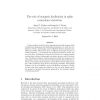Free Online Productivity Tools
i2Speak
i2Symbol
i2OCR
iTex2Img
iWeb2Print
iWeb2Shot
i2Type
iPdf2Split
iPdf2Merge
i2Bopomofo
i2Arabic
i2Style
i2Image
i2PDF
iLatex2Rtf
Sci2ools
JCNS
2008
2008
The role of synaptic facilitation in spike coincidence detection
Using a realistic model of activity dependent dynamical synapse, which includes both depressing and facilitating mechanisms, we study the conditions in which a postsynaptic neuron efficiently detects temporal coincidences of spikes which arrive from N different presynaptic neurons at certain frequency f. A numerical and analytical treatment of that system show that: i) facilitation enhances the detection of correlated signals arriving from a subset of presynaptic excitatory neurons, and ii) the presence of facilitation yields to a better detection of firing rate changes in the presynaptic activity. We also observed that facilitation determines the existence of an optimal input frequency which allows the best performance for a wide (maximum) range of the neuron firing threshold. This optimal frequency can be controlled by means of facilitation parameters. Finally, we show that these results are robust even for very noisy signals and in the presence of synaptic fluctuations produced by ...
| Added | 13 Dec 2010 |
| Updated | 13 Dec 2010 |
| Type | Journal |
| Year | 2008 |
| Where | JCNS |
| Authors | Jorge F. Mejías, Joaquín J. Torres |
Comments (0)

